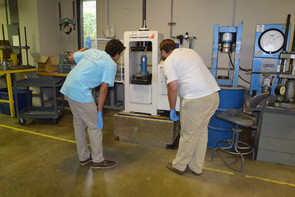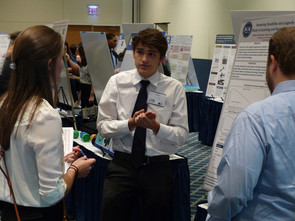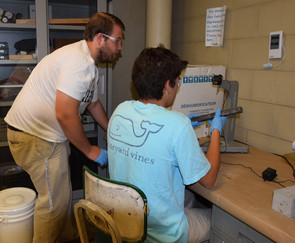Individuals from the Texas A&M University College of Engineering recently completed a 10-week research for undergraduates (REU) program that was coordinated by the college of engineering and Penn State’s College of Engineering.
The students and faculty members in the program spent five weeks at Texas A&M and five weeks at Penn State’s University Park campus conducting research in teams based on mutual areas of study.
Penn State public relations specialist Stefanie Tomlinson wrote the following story.
UNIVERSITY PARK, Pa. -- The University Park campus is perceived to be somewhat quiet during the summer months, but for six groups of engineering undergraduates, it was academics as usual. Except for one thing. They got to be involved in some pretty intense – not to mention super cool – research projects.
 The students were part of a new research experience for undergraduates (REU) coordinated by Penn State’s College of Engineering and Texas A&M’s Dwight Look College of Engineering. The program aims to promote mutual awareness and collaboration between faculty and students at both universities, as well as provide opportunities for undergraduate students to participate in research early in their academic careers, in order to broaden their engineering education.
The students were part of a new research experience for undergraduates (REU) coordinated by Penn State’s College of Engineering and Texas A&M’s Dwight Look College of Engineering. The program aims to promote mutual awareness and collaboration between faculty and students at both universities, as well as provide opportunities for undergraduate students to participate in research early in their academic careers, in order to broaden their engineering education.
Engineering students and faculty from the University Park campus were matched with engineering students and faculty from Texas A&M to form research teams based on mutual areas of study. The students spent the first five weeks of the REU at Texas A&M, followed by five weeks at the University Park campus, conducting their research.
For many of the students, including Mason DeCock, a rising biomedical engineering junior from Texas A&M, this was their first foray into the world of research.
DeCock said one of the benefits of undergraduate research is the opportunity to apply what he learned in the classroom to real-world applications, using a hands-on approach.
“I just completed a course on signals and processing of signals, and I was able to see how progress is made in the field I studied,” he said.
DeCock and his Penn State research partner, Jack Zheng, a rising junior in mechanical engineering, worked on a project titled “Understanding soft tissue and bone cutting mechanics for advanced surgical device design.”
The pair, who were advised by Jason Moore, assistant professor of mechanical engineering at Penn State, and Bruce Tai, assistant professor of mechanical engineering at Texas A&M, said the goal of their research is to perform experiments to validate a new model that will mimic how tissues are cut.
Moore said, “Traditionally people have had a difficult time trying to model the cutting of bone and tissue inside the body. But the work Mason and Jack are doing is so clever because it uses a unique system of a new type of model. Because it creates small particles rather than small fragments, it allows us more freedom to model things scaling all the way down to extremely soft tissue to very hard bone. Their research could help advance almost any kind of medical procedure.”
 Another student research duo included rising civil engineering juniors Ross Luna from Texas A&M and Robert Gowisnock from Penn State. They were advised by Aleksandra Radlinska, assistant professor of civil and environmental engineering at Penn State, and Zachary Grasley, associate professor of civil engineering at Texas A&M.
Another student research duo included rising civil engineering juniors Ross Luna from Texas A&M and Robert Gowisnock from Penn State. They were advised by Aleksandra Radlinska, assistant professor of civil and environmental engineering at Penn State, and Zachary Grasley, associate professor of civil engineering at Texas A&M.
Their project, “The effect of leaching on material and transport properties of concrete,” aims to understand how leaching affects the mechanical properties of cement mortar.
“Basically, we are testing the strength and durability of concrete. It is very broad and there are many applications for which this could be useful, including bridges and roads,” said Gowisnock.
They completed much of their work at Penn State’s Civil Infrastructure Testing and Evaluation Laboratory.
Gowisnock said he appreciated working with other students and faculty in the field and gaining different perspectives.
“Everyone approaches research differently and this has been a good opportunity to share ideas,” he said.
Luna said he has always wanted to attend graduate school and participating in this program will be a valuable stepping stone toward achieving that goal.
Students weren’t the only REU participants to weigh in on the benefits of the Penn State-Texas A&M partnership.
Tai said the REU offers a great opportunity to find experts in the peer schools for potential future collaborations.
Grasley added that the program may help recruit REU participants to the universities’ graduate programs, once the students discover the opportunities for creativity and discovery that graduate research affords.
Although the students spent a majority of their time working with their advisers to advance their research efforts, they also had ample opportunities to explore the culture in the states they visited.
While in Texas, Zheng traveled from College Station to spend one weekend in Dallas and another in Houston. Luna took advantage of his free time in Pennsylvania to check out the City of Brotherly Love, including visiting Independence Hall and the Liberty Bell and finding a good cheesesteak.
 At the end of the REU, students participated in a symposium during which they networked with peers and faculty in their fields and explained their research projects and the progress they made during the course of the 10-week program.
At the end of the REU, students participated in a symposium during which they networked with peers and faculty in their fields and explained their research projects and the progress they made during the course of the 10-week program.
Reflecting on his first experience as an REU adviser, Moore said it was interesting to see an equal investment from both universities into making the program a success.
"Sometimes it can be challenging to find projects that will kindle relationships, but this REU has given us an opportunity to do just that. Working with the engineering students and faculty at Texas A&M was unique and special, and I look forward to collaborating with Dr. Tai beyond the REU," he said.